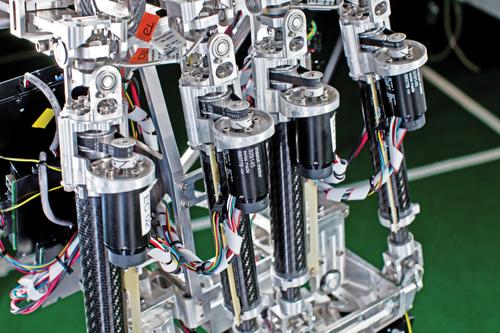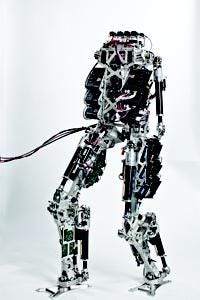June 1, 2012

Agility, speed, strength, and balance are all qualities needed to fight fires, especially when those fires are shipboard. Such feats are difficult for humans, let alone humanoid robots. But that's just what the RoMeLa labs at Virginia Tech are working on.
"The SAFFiR [Shipboard Autonomous Firefighting Robot] will be able to carry and operate fire extinguishers, fire hoses, throw PEAT [propelled extinguishing agent technology] canisters, as well as interact with humans and find fires. We've already built the legs of the robot and are working on the rest of it," said Derek Lahr, a PhD candidate and project manager.
The SAFFiR's legs are a highly compact amalgamation of motors, pulleys, wire harnesses, and controllers that allow the robot not only to walk, but also to walk while on a ship as it pitches and rolls through waves. Key concerns while designing the SAFFiR included the need to control the robot's locomotion from both a purely mechanical stance and a balance standpoint. For example, if the ship pitches forward, the robot might need to speed its leg movement and produce a longer stride length to keep itself from getting off balance.

Lahr said that by using maxon precision motors' EPOS controls, the project engineers were able to interconnect all operations easily. "For six degrees of freedom in each leg, we use six motors. That's 12 motors being used in just the legs section of the SAFFiR." Both speed and torque were necessary, since at different parts of a stride, the leg will alternately move fast and free and then slow and more controlled.
Lahr and his team used multiple 30mm maxon motors for the legs. Wherever possible, they designed in 100W motors to help reduce the weight of the unit. The motors provide the largest amount of mass in the robot, so any reduction in weight was a plus. "Maxon motors actually provide the highest power to weight ratio we could find in a brushless motor anywhere," Lahr said. "And humanoid robots can be more sensitive to weight than an airplane."
For certain critical joints like those in the knees, 200W motors were used. The knees of the robot, just like human knees, take the brunt of the load, especially when squatting or kneeling. They also have to move the fastest while walking. Those joints needed the additional torque and speed combination available with the larger wattage units.
About the Author(s)
You May Also Like





